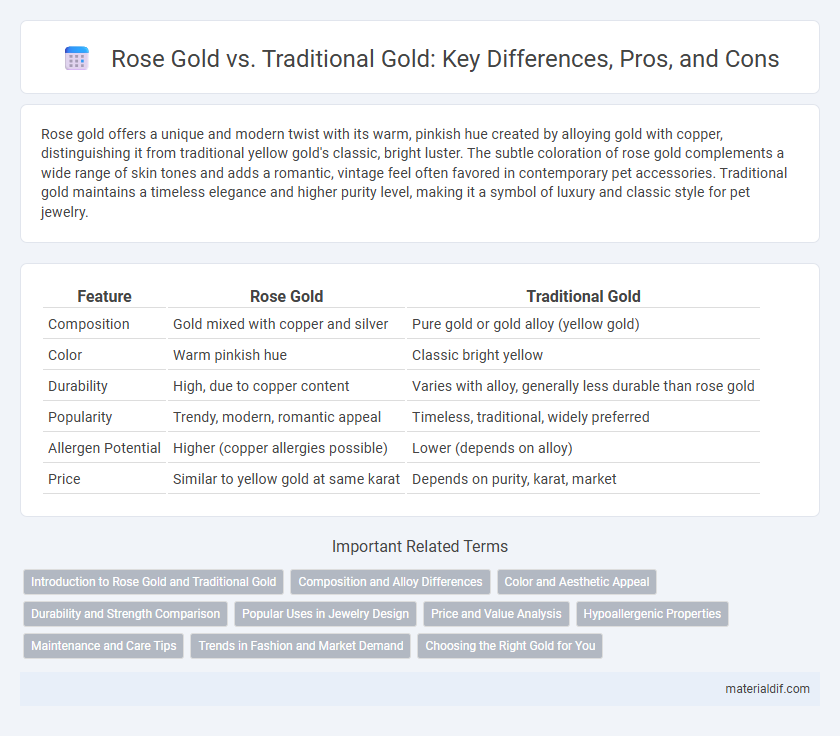Rose gold offers a unique and modern twist with its warm, pinkish hue created by alloying gold with copper, distinguishing it from traditional yellow gold's classic, bright luster. The subtle coloration of rose gold complements a wide range of skin tones and adds a romantic, vintage feel often favored in contemporary pet accessories. Traditional gold maintains a timeless elegance and higher purity level, making it a symbol of luxury and classic style for pet jewelry.
Table of Comparison
| Feature | Rose Gold | Traditional Gold |
|---|---|---|
| Composition | Gold mixed with copper and silver | Pure gold or gold alloy (yellow gold) |
| Color | Warm pinkish hue | Classic bright yellow |
| Durability | High, due to copper content | Varies with alloy, generally less durable than rose gold |
| Popularity | Trendy, modern, romantic appeal | Timeless, traditional, widely preferred |
| Allergen Potential | Higher (copper allergies possible) | Lower (depends on alloy) |
| Price | Similar to yellow gold at same karat | Depends on purity, karat, market |
Introduction to Rose Gold and Traditional Gold
Rose gold is an alloy composed primarily of gold and copper, giving it a distinctive pinkish-red hue that differentiates it from traditional gold's classic yellow color. Traditional gold, commonly used in jewelry, consists of pure gold mixed with metals like silver or zinc to enhance durability while retaining its iconic rich yellow appearance. The unique color of rose gold has gained popularity for modern designs, combining the inherent value of pure gold with a contemporary aesthetic.
Composition and Alloy Differences
Rose gold distinguishes itself from traditional yellow gold through its unique copper alloy composition, typically containing 75% gold mixed with 20-25% copper and a small percentage of silver, giving it a warm pinkish hue. Traditional yellow gold primarily combines pure gold with metals like silver and zinc to preserve its classic golden color while enhancing durability. The higher copper content in rose gold not only affects its color but also increases hardness compared to traditional yellow gold alloys.
Color and Aesthetic Appeal
Rose gold features a warm, pinkish hue created by alloying gold with copper, giving it a distinctive, romantic aesthetic compared to the classic yellow tone of traditional gold. Its unique color enhances jewelry with a vintage or modern flair, appealing to those seeking a softer, more contemporary look. Traditional gold's bright and rich yellow shade remains timeless and versatile, often associated with luxury and classic elegance.
Durability and Strength Comparison
Rose gold, an alloy of gold and copper, offers enhanced durability and strength compared to traditional yellow gold due to the hardness imparted by copper. Traditional 24k yellow gold is softer and more prone to scratches and deformation, whereas rose gold typically ranges from 14k to 18k, balancing purity with increased resistance to wear. This makes rose gold an ideal choice for jewelry items that require longevity without compromising aesthetic appeal.
Popular Uses in Jewelry Design
Rose gold, prized for its warm, pinkish hue, has gained popularity in contemporary jewelry design, especially in engagement rings and fashion accessories, appealing to those seeking a unique yet elegant look. Traditional yellow gold remains a classic choice, favored for its timeless appeal and versatility in both vintage and modern jewelry styles. Both metals are valued for their durability and ability to complement a wide range of gemstones, making them staples in fine jewelry craftsmanship.
Price and Value Analysis
Rose gold, crafted by alloying gold with copper, typically costs slightly less than traditional gold due to the lower price of copper compared to pure gold alloys. Traditional gold, especially 24k and 18k variants, maintains higher intrinsic value and market demand, influencing its premium pricing and long-term investment appeal. Rose gold's distinctive pink hue offers unique aesthetic value but usually exhibits marginally lower liquidity and resale value than classic yellow gold.
Hypoallergenic Properties
Rose gold contains a higher copper content than traditional yellow gold, which can increase the likelihood of allergic reactions in sensitive individuals. Traditional yellow gold, especially in higher karats like 18K or 24K, tends to be more hypoallergenic due to its purer gold content and fewer alloy metals. Choosing higher purity gold or hypoallergenic coatings can reduce the risk of skin irritation for those prone to metal allergies.
Maintenance and Care Tips
Rose gold requires gentle cleaning with mild soap and water to maintain its warm hue, avoiding harsh chemicals that can damage its alloy components. Traditional gold, particularly higher karats like 18K or 24K, is softer and more prone to scratches, necessitating regular polishing and careful storage in soft cloth pouches. Both types benefit from avoiding exposure to chlorine, cosmetics, and excessive moisture to preserve their luster and extend the life of the jewelry.
Trends in Fashion and Market Demand
Rose gold has surged in popularity due to its warm, pinkish hue that complements diverse skin tones and versatile fashion styles, making it a favorite in contemporary jewelry design. Traditional yellow gold remains a symbol of classic luxury and timeless elegance, maintaining steady demand among buyers seeking heritage and investment value. Market trends show rose gold outpacing traditional gold in millennial and Gen Z demographics, driven by social media influence and the desire for unique, personalized accessories.
Choosing the Right Gold for You
Rose gold offers a warm, pinkish hue due to its copper content, making it a popular choice for those seeking a unique and romantic aesthetic. Traditional gold, typically yellow gold, provides a classic and timeless appearance favored for its rich color and versatility in various jewelry styles. When choosing the right gold, consider your skin tone, personal style, and durability preferences to ensure your choice complements your collection and lifestyle.
Rose Gold vs Traditional Gold Infographic

 materialdif.com
materialdif.com